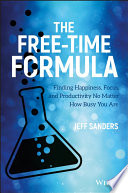

In 'The Free-Time Formula', the author emphasizes the importance of free time as a critical component of a fulfilling life. Free time is not merely a luxury but a necessity that fosters creativity, relaxation, and personal growth. The book argues that many individuals are caught in a cycle of busyness, often equating productivity with worth. By reframing our understanding of free time, the author encourages readers to prioritize it, suggesting that it is during these moments that we can engage in self-reflection, pursue hobbies, and connect with loved ones. The author provides strategies to reclaim free time, such as setting boundaries with work, delegating tasks, and learning to say no. Ultimately, the message is that free time is essential for mental well-being and should be deliberately cultivated.
Continue readingOne of the central tenets of the book is the concept of a 4-day workweek. The author presents evidence and case studies showing that reducing the workweek can lead to increased productivity and employee satisfaction. By condensing work into fewer days, individuals can focus better, reduce burnout, and enjoy more personal time. The author outlines practical steps for implementing a shorter workweek, such as prioritizing tasks, eliminating non-essential meetings, and utilizing technology to streamline processes. This idea challenges traditional work norms and encourages readers to rethink how they approach their professional lives, ultimately leading to a healthier work-life balance.
Continue readingEffective time management is crucial for maximizing free time, and the book provides various techniques to help individuals manage their schedules more efficiently. The author introduces methods such as the Pomodoro Technique, time blocking, and the Eisenhower Matrix to help readers prioritize their tasks and minimize distractions. By implementing these techniques, individuals can create more structure in their day, allowing them to complete necessary work in a shorter amount of time. The emphasis is on working smarter, not harder, and the author encourages readers to experiment with different methods to find what works best for them. This focus on time management is essential for freeing up time for personal pursuits.
Continue readingMindset plays a significant role in how individuals perceive and utilize their time. The book discusses the concept of a 'growth mindset' versus a 'fixed mindset,' explaining how those with a growth mindset are more likely to seek opportunities for improvement and embrace challenges. The author argues that developing a positive mindset toward free time can lead to more proactive choices about how to spend it. This includes recognizing the value of rest and leisure as integral to overall productivity. The book encourages readers to cultivate self-awareness and to challenge limiting beliefs about time and productivity, ultimately fostering a healthier relationship with both work and leisure.
Continue readingThe author introduces the idea of a 'personal free-time formula,' a customized framework for how individuals can allocate their time based on their values, goals, and priorities. This formula encourages readers to take a holistic view of their lives, considering not only work but also family, health, and personal interests. The author provides a step-by-step guide to creating this formula, which involves assessing current commitments, identifying time leaks, and setting clear intentions for how to use free time. This personalized approach empowers readers to take control of their schedules and make deliberate choices that align with their true desires.
Continue readingThe book emphasizes the importance of surrounding oneself with supportive people and environments that encourage a healthy balance between work and free time. The author discusses how social circles, workplace culture, and even physical spaces can influence our ability to reclaim free time. By fostering relationships with like-minded individuals who value leisure and personal growth, readers can create a network that supports their goals. The book also addresses the role of organizations in promoting work-life balance and suggests ways to advocate for a culture that prioritizes employee well-being. Building a supportive environment is presented as a vital step in making sustainable changes to how we manage our time.
Continue readingIn the modern world, technology can be both a boon and a bane when it comes to time management. The author explores how technology can be leveraged to enhance productivity and free up time but also warns against its potential to distract and overwhelm. The book provides insights into using tools and apps that can help streamline tasks, automate processes, and minimize time spent on mundane activities. However, the author also emphasizes the importance of digital detox and setting boundaries with technology to prevent it from encroaching on free time. The key takeaway is to harness technology's benefits while being mindful of its pitfalls.
Continue reading